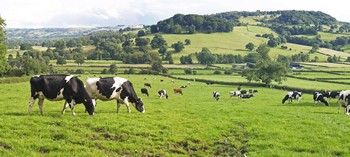The lack of sun is curbing the mating instincts of dairy cows and Manawatū/Rangitīkei farmers expect fertility levels will be lower than normal.
While mating hasn’t started, farmers are keeping an eye on cows and have found fewer than usual are cycling because of cool and cloudy weather.
Cow fertility levels were discussed among about 45 farmers and a handful of rural professionals during a dairy discussion day for the Foxton group in Horowhenua at Simon Easton’s farm.
Easton said rain had taken a toll on people and animals with only two thirds of his cows cycling and numbers would usually be higher at this stage.
 “The impact on non-cycling numbers is from the cold weather and lack of sunshine. Cows, like people need vitamin D.”
“The impact on non-cycling numbers is from the cold weather and lack of sunshine. Cows, like people need vitamin D.”
He hoped more cows would be cycling by the time mating started on October 19.
“We have put it back a week, we used to mate on October 12, but it is easier on the cows, and people, if it is a week later.”
Easton said water was still lying on about one tenth of the farm.
“Crops will go in later than expected, as a result of water lying on fields which are to go into turnips.”
He said dairying’s balance date had been achieved and pasture was keeping up with cow demand. Milking cows were, however, still being fed a mixture of pasture silage and palm kernel mixed with grain and human food waste to milking cows.
“It is high energy food. Just like human athletes have.”
He said his cows were at peak milk production at the moment and he hoped it would last three to six weeks.
“We try to make the decline in milk production as slow as we can.”
Most farmers had a handful of cows still to calve,
“We had six due last week, but they are hanging on.”
Easton has an 860 cow herd of spring calvers and about 200 autumn calvers, which were milked through winter.
“When we calved, we had a good run. It was wet, and we had to put on wet weather gear to go out. That was the hardest part for us.”
Easton said he lost five cows through theileria and calving issues.
The farm has a sandy base below the topsoil on hills and gullies as well as some flat land.
“It is not an easy farm as it’s not uniform like some farms and it’s hard to get everything right.”
He had a separate mob of 205 heifers which were on once-a-day milking to help prepare them for mating.
Easton said he used sexed semen for his high producing cows .
LIC said there was only an eight breeding worth (BW) points difference between fresh semen and frozen semen.
The genetic company’s Premier Sires (frozen) daughter proven team averaged 183 BW points while the sexed semen (which has to be fresh) team has a BW of 175 points.
“We are unable to utilise the daughter-proven bulls in sexed semen at present as their demand for conventional fresh semen at this time of the year is too high. However, farmer uptake for sexed semen is increasing each year so this is will continue to be reviewed each season.
Federated Farmers Manawatū/Rangitīkei sharemilker chairman Richard McIntyre said it was still wet on farms with surface water still in most paddocks.
“Balance date [when pasture meets cow consumption] is roughly two weeks later than normal. Palm kernel (PKE) orders were out to two weeks, which shows that dairy farmers throughout the North Island are using PKE to fill the gap.”
He said people would normally start to put crops in, but the weather and ground conditions were not allowing this.
Like most dairy farmers he was hoping for some better October weather.
“Some warm sunny days would certainly help the cows to cycle.”
Source: NZFarmer.co.nz




